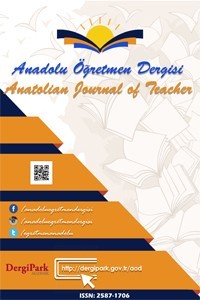BİRAZ DAHA DOĞA! DOĞA YOKSUNLUĞUNUN AZALTILMASI İÇİN KAPALI MEKÂNLARDA YAPILABİLECEK DOĞA EĞİTİMİ ÖRNEKLERİ
Doğa eğitimi, çevre eğitimi, kapalı alan doğa eğitimi
SOME MORE NATURE! EXAMPLES OF NATURE EDUCATION THAT CAN BE DONE INDOOR TO REDUCE NATURE DEFICIENCY
___
- Boldemann, C., Blennow, M., Dal, H., Martensson, F., Raustorp, A., Yuen, K. & Wester, U. (2006). Impact of preschool environment upon children’s physical activity and sun exposure. Preventive Medicine, 42, 301–308.
- Bratman, G.N., Hamilton, J.P. & Daily, G.C. (2012). The impacts of nature experience on human cognitive function and mental health. Annals of the New York Academy of Sciences, 1249, 118–136.
- Byström, K., Grahn, P. & Hägerhäll, C. (2019). Vitality from Experiences in Nature and Contact with Animals—A Way to Develop Joint Attention and Social Engagement in Children with Autism?. International Journal of Environmental Research and Public Health, 16(23), 4673.
- Courtauld S. & Mason C. (2011). Doğa - Deniz Kıyısı. TÜBİTAK Popüler Bilim Kitapları, Ankara.
- Davidson S., Courtault S. & Davies K. (2010). Doğa - Kuş Gözlem. TÜBİTAK Popüler Bilim Kitapları, Ankara.
- Fjørtoft, I. (2004). Landscape as Playscape: The Effects of Natural Environments on Children’s Play and Motor Development. Child. Youth Environ., 14, 21–44.
- Hinkley, T., Salmon, J. O., Okely, A. D., Crawford, D. & Hesketh, K. (2012). Preschoolers' physical activity, screen time, and compliance with recommendations. Medicine and Science in Sports and Exercise, 44(3), 458-465.
- Howell L. (2011). Doğa - Ağaçlar. TÜBİTAK Popüler Bilim Kitapları, Ankara.
- Jiang, B., Chang, C. Y. & Sullivan, W.C. (2014). A dose of nature: Tree cover, stress reduction, and gender differences. Landscape and Urban Planning, 132, 26–36.
- Kaplan, S. & Berman, M.G. (2010). Directed Attention as a Common Resource for Executive Functioning and Self-Regulation. Perspectives on Psychological Science, 5, 43–57.
- Khan S. & Rogers K. (2010). Doğa - Yabani Çiçekler. TÜBİTAK Popüler Bilim Kitapları, Ankara.
- Kirmani, M. H., Grodzinsky, I. B., Vasanth, N. M., & Steele, B. M. (2021). Tumbling Down the Green: Nature-Based Play and Learning in Young Children. In Building STEM Skills Through Environmental Education (pp. 91-115).
- Mårtensson, F. (2004). Landskapet i leken: En studie av utomhuslek på förskolegården. Ph.D. Thesis, Swedish University of Agricultural Sciences, Alnarp, Sweden.
- Meteoroloji Genel Müdürlüğü. (2021). Bulutlar. 30 Ekim 2021’de https://www.mgm.gov.tr/genel/sss.aspx?s=bulutlar sayfasından erişilmiştir.
- Pinney G. P. (2010). Bulut Gözlemcisinin Rehberi. TÜBİTAK Popüler Bilim Kitapları, Ankara.
- Reid S. (2012). Doğa - Kayaçlar ve Fosiller. TÜBİTAK Popüler Bilim Kitapları, Ankara.
- Sandell, K. & Öhman, J. (2010). Educational potentials of encounters with nature: Reflections from a Swedish outdoor perspective. Environmental Education Research, 16, 113–132.
- Standish, K. (2021). Suicide, Femicide, and COVID-19. Peace Review, 33(1), 71-79.
- Türk Dil Kurumu Sözlükleri. (2021). Niş. 1 Kasım 2021’de https://sozluk.gov.tr/niş sayfasından erişilmiştir.
- Ward Thompson, C., Roe, J., Aspinall, P., Mitchell, R. & Clow, A. (2012). Miller, D. More green space is linked to less stress in deprived communities: Evidence from salivary cortisol patterns. Landscape and Urban Planning, 105, 221–229.
- World Meteorological Organization. (2021). Identifying clouds. Retrieved November 1, 2021 from https://cloudatlas.wmo.int/en/identifying-clouds.html
- Yayın Aralığı: Yılda 2 Sayı
- Başlangıç: 2017
- Yayıncı: Naim UZUN
ÖĞRENCİLERİN KİMYA LABORATUVARI ENDİŞELERİNE YÖNELİK GÖRÜŞLERİ
PARMAK İZİ ÇEŞİTLERİNE GÖRE ÖĞRENCİLERİN FEN BİLİMLERİ DERSİNDEKİ AKADEMİK BAŞARILARI
Emir Efe KARAYEL, Zeynep ÖZCAN, Miraç MUDU, Nazli BARIŞ
FEN BİLGİSİ ÖĞRETMENLERİNİN NÖROFİZYOLOJİK ÖĞRENME ALGI DÜZEYLERİNİN İNCELENMESİ
Eray SELÇUK, Abdullah Ata TEZBAŞARAN
Hüseyin Cihan BOZDAĞ, İsa GÖKLER
FEN BİLİMLERİ ÖĞRETMENLERİNİN ÖĞRETİM SÜRECİNDE TEKNOLOJİ KABUL VE KULLANIMLARINA İLİŞKİN GÖRÜŞLERİ
